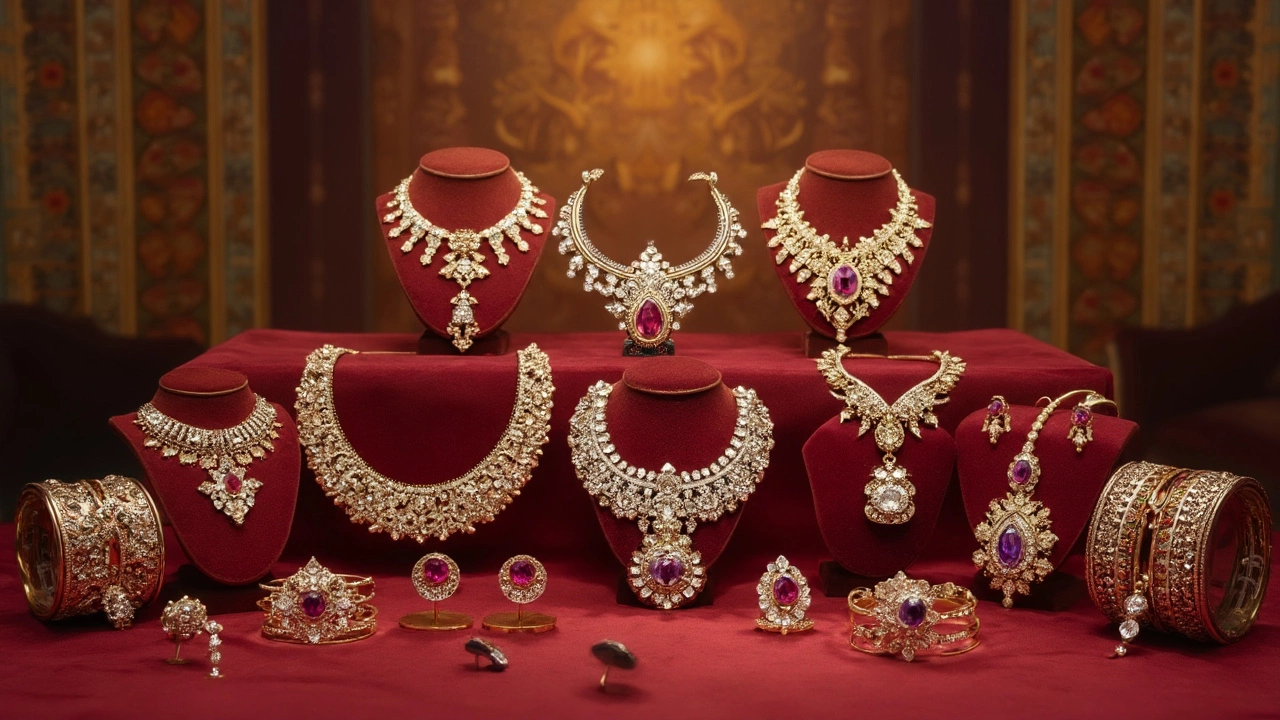So, you're curious about cubic zirconia, especially in the context of antique jewelry. It's worth knowing that cubic zirconia often gets mistaken for diamonds due to its striking similarity in appearance. This synthetic stone is created in labs but let's not underestimate its beauty just because it's not naturally occurring.
When it comes to antique jewelry designs, cubic zirconia can be a star. Its clarity and brilliance rival that of the finest gemstones, but without the hefty price tag. This makes it a favorite among designers looking to create intricate and showy pieces with a vintage flair.
What should you look for? Well, cubic zirconia shines with a brilliance that's quite an eyeful. It doesn’t have the intense fire of diamonds, but its sparkle is nothing short of spectacular. And here's a fun fact: it’s available in a plethora of colors, adding to its versatility in antique-style designs.
- Understanding Cubic Zirconia
- Historical Context in Jewelry
- Visual Characteristics
- Identifying Cubic Zirconia in Antiques
- Caring for Cubic Zirconia
- Why Choose Cubic Zirconia in Designs
Understanding Cubic Zirconia
Cubic zirconia is a lab-created gemstone known for its stunning diamond-like appearance. First synthesized in the late 1970s, it rapidly gained popularity as an affordable alternative to diamonds. This is because it mimics the diamond's sparkle and clarity without the associated cost.
So, what makes it special? Well, its creation process involves zirconium dioxide being heated to extreme temperatures until it forms cyrstals. These crystals are then cut and polished to perfection. Unlike natural gemstones, cubic zirconia has flawless clarity and sparkles with amazing radiance.
Properties of Cubic Zirconia
- Appearance: It closely resembles a diamond but can be produced in a wide range of colors, providing versatility in jewelry designs.
- Density: A tad denser than diamonds, making it feel heavier compared to a similar-sized diamond.
- Hardness: It ranks at 8.5 on the Mohs scale, which makes it quite durable, but not as tough as a diamond.
Manufacturing Process
The creation of cubic zirconia is fascinating. Using the skull-melting technique (yep, that's its name), manufacturers can consistently produce high-quality stones. There's meticulous detail involved – from the heating process to the cooling methods, ensuring each stone maintains its luster.
In the jewelry world, antique jewelry designs featuring cubic zirconia can have a unique charm. It allows collectors and enthusiasts to enjoy the aesthetics of vintage pieces without the premium cost of natural gemstones.
Overall, cubic zirconia offers not just an attractive look but also provides a budget-friendly option, appealing to both jewelers looking to create exquisite designs and jewelry lovers wanting something beautiful and timeless.
Historical Context in Jewelry
When we talk about the history of jewelry, the introduction of cubic zirconia is relatively recent, dating back to the 1970s. It started popping up as a synthetic alternative during an era when technology and luxury began to merge more closely. Jewelers and designers were quick to notice how much cubic zirconia could offer in durability and appearance without the high costs associated with natural gemstones.
In the world of antique jewelry, cubic zirconia found its place by mimicking more expensive stones. Post-World War II, a shift happened—people wanted accessible luxury, and that's when cubic zirconia became a game-changer. It was all about creating designs that were grand yet affordable, and this is where cubic zirconia really shined. Jewelers could finally create the intricate, lush designs from the Victorian and Art Deco eras without charging a fortune.
From Lab to Bijoux
Initially, cubic zirconia was used primarily for industrial applications due to its cost-effectiveness and toughness—it doesn't chip as easily as other stones. However, that soon changed as the brilliant sparkle of cubic zirconia caught the eye of jewelers. It fit in perfectly with a variety of settings, often replacing diamonds in rings, earrings, and necklaces designed to evoke the glamour of past epochs.
Despite its modern roots, cubic zirconia is seen in replicas of antique jewelry designs, contributing to the retro wave in fashion. It allows those who love the antique look to own a piece of history without having to shell out a historical price.
Jewelry Design Evolution
Jewelry design has always been a reflection of the times, and cubic zirconia played its part in the evolution. Before its introduction, options were limited to diamonds and other precious stones for high-end jewelry. With cubic zirconia's debut, designers could play with styles and forms once out of reach for the average consumer. It directly contributed to democratizing style, removing barriers based on class that had long defined the history of jewelry.
So, while cubic zirconia might not have the ancient legacy of diamonds, its presence in the history of jewelry over the last few decades is undeniably impactful. Its journey from laboratory curiosity to a staple in high fashion illustrates its role as both a disruptor and a democratizer, showing us yet again how innovation can redefine tradition.
Visual Characteristics
When you're talking about cubic zirconia, the visual flash is what catches your eye right away. Let's unpack the specifics that make this gem a popular choice in antique jewelry.
Brightness and Clarity
Cubic zirconia is known for its remarkable brightness. Its structure allows for almost perfect clarity, free from the imperfections that diamonds often contain. This pristine look is what makes it visually appealing, especially in vintage-inspired designs where clarity can add so much character.
Sparkle and Fire
The sparkle of cubic zirconia in jewelry rivals that of more expensive stones. Unlike diamonds, it offers a noticeable brilliance with a more subtle fire. It reflects light in an impressive way, but without that intense diamond-like fire which can sometimes be overwhelming.
Color Range
One of the features that sets cubic zirconia apart in the realm of antique jewelry design is its versatility in color. You can find it in a wide array of hues, from deep blues to rich reds, and this can allow for some creativity when matching with different settings.
Density and Weight
Here's a fact to chew on: cubic zirconia is heavier than diamond. If you place two equal-sized stones side by side, the cubic zirconia will weigh more. This can be both a selling point and a trait to note for anyone identifying stones in vintage collections.
| Property | Cubic Zirconia | Diamond |
|---|---|---|
| Hardness | 8.5 | 10 |
| Refractive Index | 2.15-2.18 | 2.42 |
| Specific Gravity | 5.6-6.0 | 3.5 |
Now, when you're examining a piece of antique jewelry and feel the weight is a bit hefty for its size, it might just be cubic zirconia shining back at you.

Identifying Cubic Zirconia in Antiques
Spotting cubic zirconia in antique jewelry can be a mystery for many, but I'm here to spill the beans on how to tell if that dazzling gem is what it appears to be. First off, remember, cubic zirconia stones are often flawless—like, really flawless. If you see a stone in antique jewelry that's seemingly perfect without any blemishes or color changes, there's a pretty good chance it could be cubic zirconia.
Clues in the Setting
Look at the setting and craftsmanship of the piece. Antique jewelry settings are usually intricate and detailed. If the stone seems overly large or heavy compared to its setting, that could be a hint. Cubic zirconia is denser than diamonds, making it heavier.
Understanding Refractive Index
This might sound technical, but it's handy to know. Cubic zirconia has a refractive index of about 2.15, just a bit lower than a diamond's 2.42. To an untrained eye, this means the sparkle or "fire" might not seem as sharp when compared to real diamonds. If you have access to a refractometer, which measures this, it’s a surefire way to check.
Double Checking with Tools
- A magnifying glass can reveal the presence of rounded edges or a beaming spectrum of rainbow colors, again hinting at cubic zirconia.
- Weighing the stone can also help because cubic zirconia weighs about 1.7 times more than a diamond of the same size.
The Water Test
An easy at-home test involves simply dropping the stone in water. Real diamonds sink, but strong contenders like glass and cubic zirconia might float or hover awkwardly.
Price Check
If you're making a purchase, let the price guide you too. A price tag that seems astonishingly low for the size and beauty of the stone might indicate it's not a real diamond—but perhaps a lovely cubic zirconia.
With these tips, you're armed with the basics of identifying cubic zirconia in antique jewelry. Whether you're an avid collector or just eyeing a piece for a special occasion, these insights can definitely help you make an informed decision!
Caring for Cubic Zirconia
Looking to keep your cubic zirconia pieces shining bright? It's easier than you think, and a little regular care goes a long way. Even though cubic zirconia is tough, it's not indestructible, so you want to handle it carefully to maintain its sparkle.
Daily Maintenance
As with any jewelry, avoid exposing your antique jewelry to harsh chemicals. This includes household cleaning products which might cause a buildup that dulls the shine. When you're heading out for a swim or doing chores, it's a smart move to remove your zirconia pieces.
Regular Cleaning
Keep your jewelry clean with a simple routine. Mix some lukewarm water with mild soap. Use a soft brush, like a toothbrush, to gently scrub your jewelry design. Rinse it under running water and pat dry with a soft cloth. Make sure no residue remains in the settings.
Once in a while, if the sparkle seems a bit dim, consider using a jewelry cleaner that's specifically safe for stones. Always double check the cleaner’s label for compatibility with zirconia.
Storage Tips
- Store pieces individually in soft cloth pouches or in slots of a jewelry box to avoid scratches.
- Keep them away from direct heat or sunlight to prevent any potential damage.
- If possible, keep your jewelry in a low-humidity environment to prolong its shine.
Table
| Aspect | Recommendation |
|---|---|
| Cleaning Frequency | Once a month |
| Brush Type | Soft-bristled |
| Soap Type | Mild, non-abrasive |
Remember, taking these steps not only maintains the shine but also increases the longevity of your cherished cubic zirconia pieces. Respect your gemstone look by treating it with care, and it'll keep its allure for years to come.
Why Choose Cubic Zirconia in Designs
When it comes to creating stunning jewelry, cubic zirconia is a top pick for many reasons. First off, it's super affordable compared to real diamonds, meaning you can get all the sparkle without emptying your wallet. This makes it perfect for those who love a little bling in their antique jewelry without the guilt of overspending.
Another big win for cubic zirconia is its versatility. Available in a rainbow of colors, it allows for endless design possibilities. Whether you're going for a classic clear look or something bold and colorful, cubic zirconia has you covered. Jewels can be cut into basically any shape, so they fit easily into various jewelry designs.
Durability and Maintenance
Don’t underestimate its durability either. Cubic zirconia ranks 8.0 on the Mohs scale of hardness, making it tough enough to withstand the demands of daily wear. It's a lot harder to scratch than softer stones like pearls or opals. Plus, keeping it shiny is a breeze; just a little warm soapy water and a gentle brush can bring back that sparkle in no time.
Environmental and Ethical Considerations
If you're concerned about ethical sourcing, cubic zirconia is an attractive alternative to mined stones. Being lab-created, it doesn’t involve environmental degradation or questionable mining practices. So, if supporting eco-friendly practices is important to you, cubic zirconia fits the bill perfectly.
Embracing cubic zirconia in your antique jewelry designs means you can enjoy gorgeous pieces that reflect traditional styles without sacrificing quality or ethics. It's a choice that balances beauty, affordability, and responsibility, making it a gem in the world of jewelry.
Popular Uses and Trends
In terms of trends, cubic zirconia continues to appear in increasingly sophisticated designs. From vintage-inspired statement necklaces to delicate art deco rings, its role in antique-style jewelry is undeniable. Collectors and fashion enthusiasts often praise its appeal as a timeless and versatile gem for various accessorizing needs.



